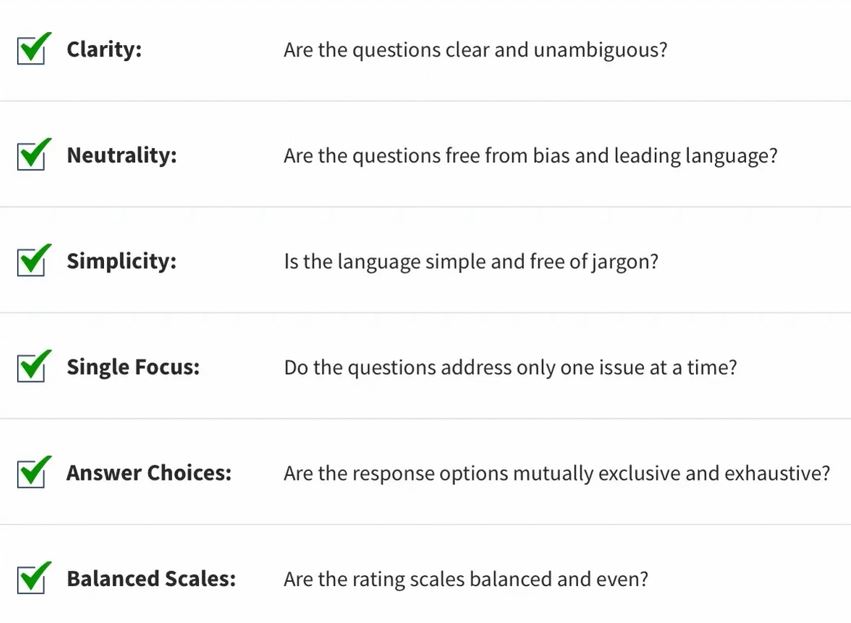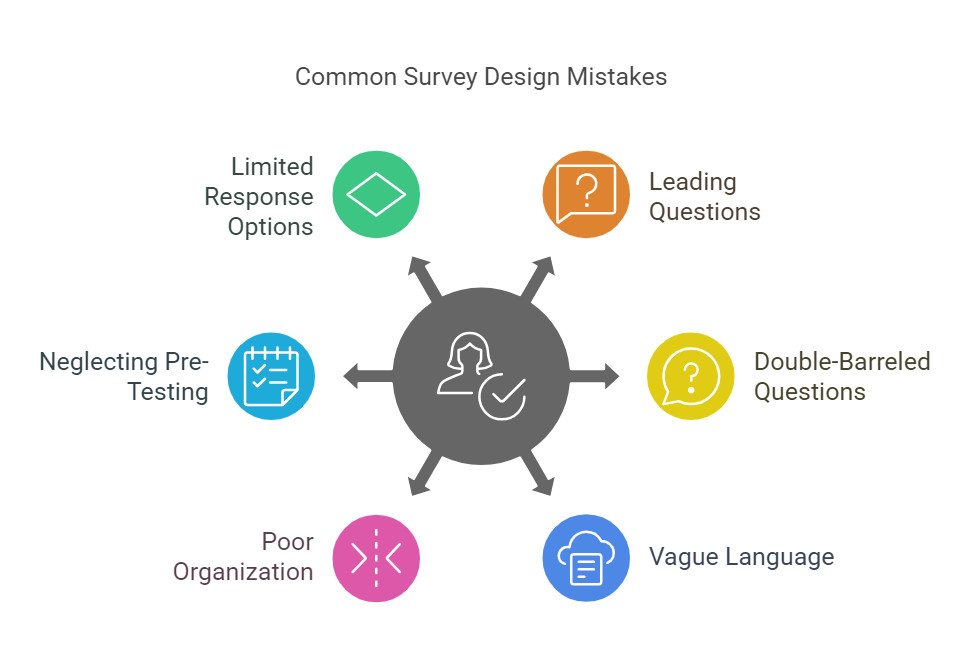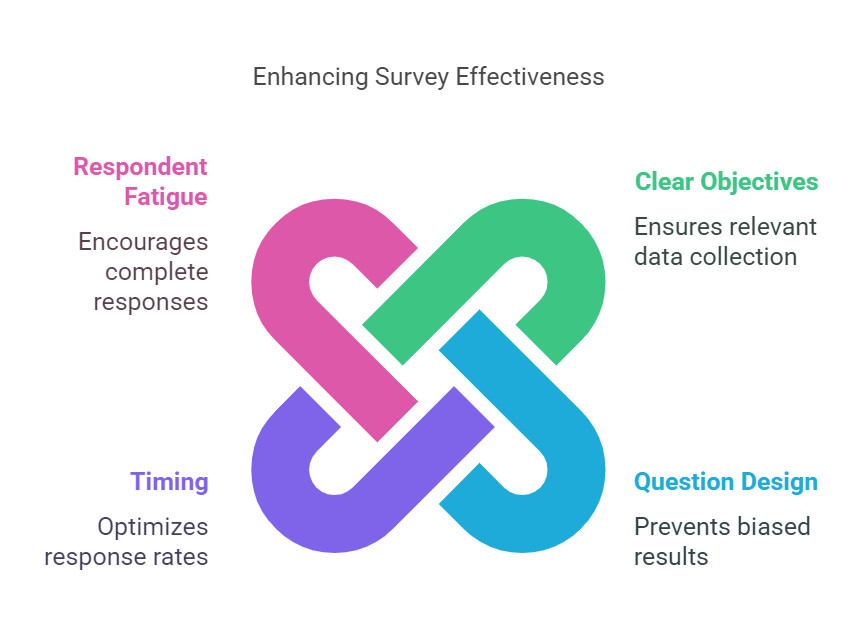- Research platform
Sources of information
Data analysis
Actions
- Solutions
For whom
Problems / Issues
- Materials
Materials
- About us
About us

Ever filled out a survey that made you wonder about good survey questions? When you do research or need feedback, good survey questions are key for gathering data that's helpful and trustworthy. Even well-made surveys can fail if not done right. This article looks into why a good survey isn't always sufficient, focusing on the need for effective questions and common mistakes in design that can affect results.
This article explores implications of survey bias and factors causing surveys to fail. We share important guidelines for improving your survey quality. You will find tools that help in getting better results. If you want to improve your survey skills and get valuable insights from your questions, you are in the right spot. Let's dive into the challenges of survey design and execution to make sure your research efforts are effective as can be.
Good survey questions play a crucial role in gathering reliable responses. A structured question greatly boost the data quality collected, while a poorly designed one can confuse the respondents. It's vital to know what makes a good survey question. Clarity, relevance, and the ability to elicit precise info are key traits. If questions are tailored and straightforward, respondents engage more thoughtfully.
The importance of achieving good survey questions influence data quality immensely. Exact questions yield precise responses, enhancing the validity of findings. This shows businesses and researchers must spend time refining question design. Closed-ended questions provide set options for respondents, yielding quantifiable data that's easier to analyze. Open-ended questions, however, offer richer insights but might produce varied interpretations complicating data aggregation.
For example, let's compare a good and bad survey question: "How satisfied are you with our service? (Very Satisfied, Satisfied, Neutral, Unsatisfied, Very Unsatisfied)" serves as a good survey question. It's clear and concise and covers the satisfaction spectrum. Conversely, a question like "What do you think about our service?" is vague, leading to inconsistent answers, complicating the drawing of significant conclusions.
This means crafting good survey questions involves more than merely asking. It's key to ensure that they convey intent and are easy for all respondents to understand. This attention to how questions are formed is foundational for effective surveys.
Understanding the significance of creating good survey questions allow us to move to common survey design pitfalls that affect data quality and lead to poor outcomes.

Creating good survey questions matters when you want to collect useful insights. However, many design mistakes can lower the effectiveness of even the most well-intended questions. Understanding these mistakes helps to avoid biased data and ensures your survey produces practical results.
One major mistake involves leading questions. They suggest a specific answer, biasing the respondent. For instance, asking "How much do you love our product?" leads the respondent to expect a positive reply, which may not reflect true feelings. This may inflate positive feedback misleading decision-makers. To fix this, it's important to use a neutral tone. A better-formulated question could be, "What do you think about our product?" This asks for honest and varied feedback.
Another frequent error is called double-barreled questions, which ask two questions at once. This combination makes it unclear which part the participant is supposed to respond to. So, a question like "How satisfied are you with product quality and customer service?" can be confusing. This leads to unreliable data. To solve this issue, break such questions into two clear inquiries, promoting clearer responses.
Vague language also affects survey results negatively. Undefined questions may be interpreted differently by respondents, causing inconsistent data. For example, terms like "often" or "seldom" lack clear meaning and can lead to diverse interpretations. Therefore, clear language is essential for uniformity in responses, allowing easier data analysis.
Moreover, poorly organized surveys may disengage participants. Surveys that shift topics abruptly frustrate respondents, possibly causing dropouts or careless responses. A well-structured survey guides participants logically, which fosters higher completion rates and better quality answers. Organizing the survey enhances thoughtful replies while lessening cognitive burden.
Another big mistake is neglecting pre-testing surveys. Skipping this testing phase risks unexpected problems. It helps spot confusing questions, technical issues, or even inappropriate lengths. Conducting a pre-test offers insights on how actual respondents interpret questions and if the survey reaches its goals, so needed adjustments can be done before wide distribution.
Finally, providing limited options for responses, particularly in multiple-choice formats, distorts results. When choices lean toward one outcome, it can hinder true expression, leading to poor data quality. More diverse options allow respondents to express accurate opinions. Including an "Other" choice can capture insights that listed options miss.
In conclusion, turning good survey questions into effective data collection tools requires close attention to these common mistakes. Addressing these design flaws will improve the survey's framework as well as greatly enhance the data's quality, yielding more precise insights.
Survey bias includes systematic errors that compromise the validity of survey results. This happens when various factors impact participant responses, resulting in outcomes that may not truly capture the sentiments or opinions of the entire population. Multiple types of survey bias exist, like response bias and non-response bias.
Response bias arises when participants provide incorrect answers. Reasons include the way survey questions are worded, social desirability, or misunderstanding the questions themselves. If people are asked about a delicate topic, they might give answers that they feel are socially acceptable instead of their real feelings. Non-response bias can also happen. This occurs when certain people do not answer the survey or choose not to answer specific questions. When non-respondents differ greatly from respondents, results may be skewed, missing important views that reflect the whole population.
The results from such biases can be serious. Invalid results may lead organizations to make poor decisions, which impact policies, product development, and other initiatives. For example, health organizations surveying patients regarding a treatment with high non-response bias might end up with misleading findings. These findings could misrepresent the treatment's effectiveness, which could lead to wrong public health guidelines.
It's necessary to recognize and minimize these biases during survey design and implementation. Several strategies may help reduce survey bias. They can ensure questions remain clear and objective, test the survey with a small group prior to broader distribution, and use randomized sampling methods to gain a representative sample. Using various channels to boost response rates can also help. Offering rewards for taking part or giving multiple ways to complete the survey ensures comprehensive feedback across different demographic groups.
Recognizing survey bias is key for ensuring good survey questions produce accurate, meaningful results. Tackling these biases improves the dependability of survey outcomes and supports better decisions. Survey quality can suffer from many factors, so as we move forward to the next part, we must analyze deeper issues that weaken survey effectiveness.

Surveys are key for gathering insights, but many yield bad responses. This impacts the data quality. A major reason is unclear objectives. Seeking professional advice can help avoid unclear objectives. Surveys without set goals collect irrelevant data. Ambiguous questions fail to prompt good responses and actionable insights.
A property survey can help identify potential issues and ensure clear objectives. The design and phrasing of good survey questions also matter. Confusing questions lead to irrelevant answers or disengagement. Leading or biased questions distort survey results. It is crucial to maintain neutrality. If ignored, surveys can show a skewed interpretation of their findings.
Timing affects survey delivery too. People respond less if surveys arrive during busy hours or holidays. Even good surveys can struggle for attention. When distractions occur, participation dips and response quality declines. This compromises overall survey effectiveness.
Respondent fatigue presents a common issue. Surveys that are too long or complex lead to incomplete responses. Many participants stop answering out of frustration. Studies show 80% luxury respondents abandon surveys early. This proves that clear and brief questions enhance data collection.
In conclusion, preventing survey failures starts with clear objectives. Good survey questions are unbiased and well-structured. Timing plays an important role as well. Keeping surveys concise greatly improves engagement. By focusing on these areas, organizations can gather quality insights for better decision-making.
Choosing the right survey method for your needs can be a daunting task, especially for first-time homebuyers. With various types of property surveys available, it’s essential to understand the differences between them to make an informed decision. Here are some factors to consider when selecting a survey method:
By considering these factors, you can choose the right survey method that meets your needs and ensures a smooth property purchase process.
To create good survey questions that provide valuable data, one must identify and sidestep the problems typical of poor quality surveys. These surveys frequently feature vague questions, irrelevant content, and unclear objectives. Choosing the right type of home survey is crucial to gather quality data. We now explore ways to ensure your surveys are effective.
First, defining criteria for spotting low quality surveys is essential. A common indicator is leading questions. They distort results and misrepresent respondents’ actual views. Questions lacking clear goals stray from research aims, reducing their usefulness. Surveys failing to regard the respondent’s viewpoint can confuse them, leading to low participation.
Next, highlight effective survey design traits. Good survey questions are clear, brief, and aligned with the survey purpose. Use simple language that is easy to understand. This improves the chance of gathering quality responses. A balanced variety of question types, including multiple-choice, Likert scales, and open-ended questions generates a fuller picture of opinions. Engaging with a house surveyor can ensure the survey questions are clear and relevant.
The significance of question clarity and relevance is crucial. Every question should fulfill a designated role, reinforcing the overall aim of the survey. Each query included needs careful consideration to determine its necessity, as irrelevant questions can burden respondents and distract from the survey focus. This clarity also aids analysis, allowing easier extraction of insights.
Furthermore, while designing surveys, it’s crucial to address the demographic consistency of the target audience. Tailoring questions to the experiences of respondents can greatly enhance engagement and data quality. For example, language appealing to younger individuals may differ from that used to attract older groups. Matching tone and content to the audience boosts the chance of getting thoughtful answers.
In conclusion, following these recommendations can markedly enhance your survey design and implementation. By spotting signs of low quality surveys and prioritizing clarity, relevance, and design, researchers can evade frequent traps and collect more reliable and instructive data.
As we progress, the upcoming section will investigate how various tools can improve survey results, leading to enhanced data collection and analysis.

If issues are flagged in your survey results, it’s essential to take action to address them promptly. Here are some steps to follow:
By following these steps, you can effectively manage any issues flagged in your survey results, ensuring a smoother property purchase and safeguarding your investment.
In today's landscape, good survey questions are crucial for collecting insights. Using the right tools can greatly improve survey design and results. Switching from simple methods to advanced features leads to structured approaches and better user experiences.
YourCX is a strong option for managing customer feedback. It features tools that enhance survey effectiveness. With it, businesses can create customized surveys that appeal to respondents. Using tailored templates and detailed analytics ensures that your survey questions prompt high responses and valuable data.
Plus, automation in YourCX makes survey distribution easy and quick, reducing human errors found in traditional ways. Utilizing these features allows firms to lead with good survey questions based on earlier findings. They can enhance the data collection process overall.
Using these tools boosts not just response rates but also the quality of feedback gained. Surveys with attention to design and strong analytical tools help discover trends and customer insights that may go unnoticed. Consequently, companies that adopt modern survey tools gather useful data, turning it into strategic actions to improve customer experiences and support growth.
Creating a strong survey requires more than good survey questions. This article showed how important well-designed questions are. We pointed out common mistakes in design that cause unreliable data. We also talked about how bias affects the survey responses. Moreover, we considered factors that lead to survey failure, offering guidelines to steer clear of issues. Lastly, we mentioned useful tools that can help enhance survey results.
With this info, you can start craft your own good survey questions. Use the practices shared here. Each survey is a chance to learn, so aim for good results and avoid average ones.
Your quest for effective surveying will help gather better feedback and improve decision-making. A careful design approach can help you collect data in a way that engages the audience, making sure results show their true thoughts.
Copyright © 2023. YourCX. All rights reserved — Design by Proformat